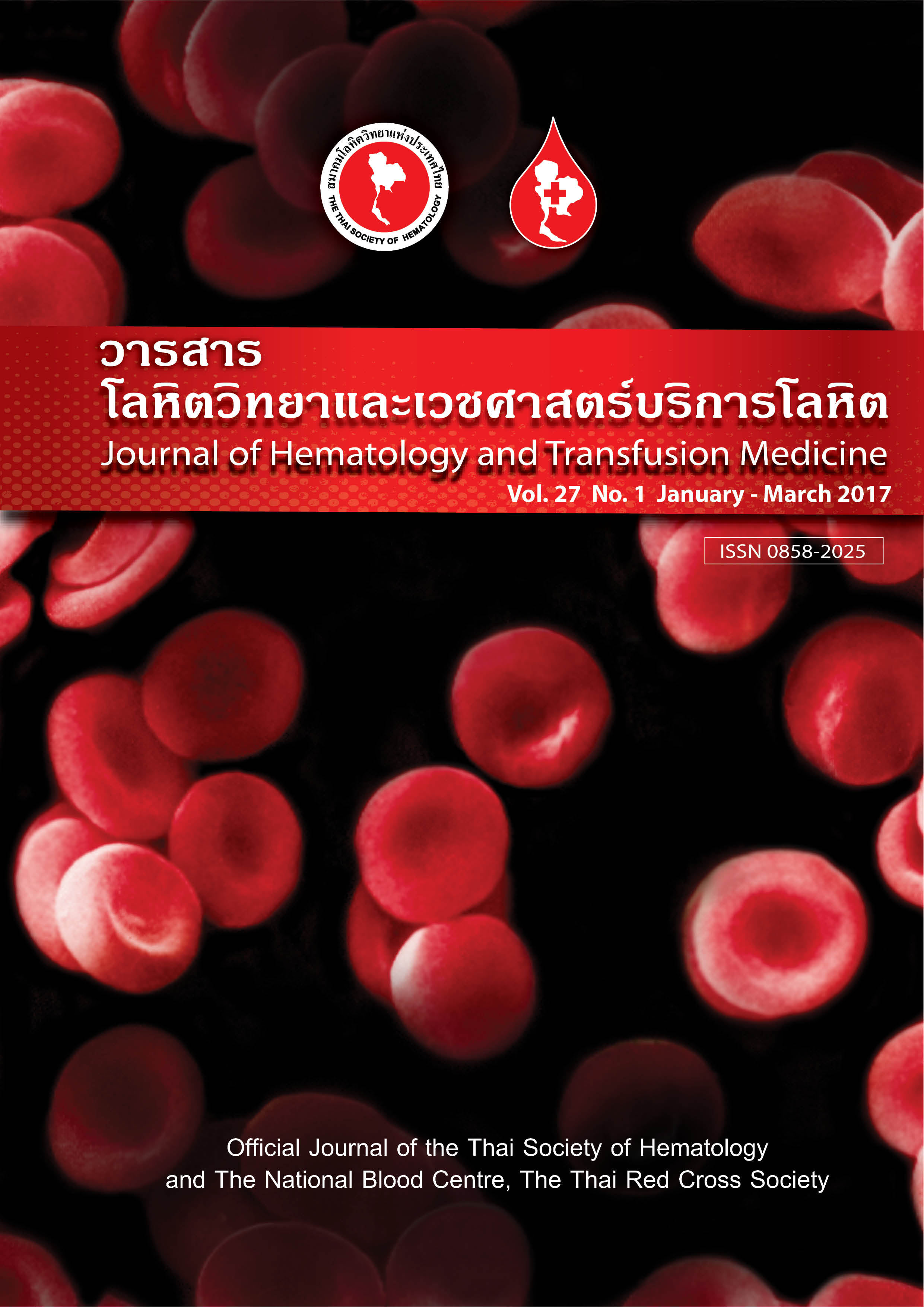การศึกษาความชุกของอัลลีล DI*A และ DI*B ในผู้บริจาคโลหิตคนไทยภาคเหนือ
Keywords:
DI*A, DI*B, Allele frequencies, PCR-SSP, Northern ThaisAbstract
บทคัดย่อ
การศึกษานี้มีวัตถุประสงค์เพื่อศึกษาความชุกของอัลลีล DI*A และ DI*B ของผู้บริจาคโลหิตคนไทยภาคเหนือและเปรียบเทียบความชุกของอัลลีลกับกลุ่มประชากรอื่นๆ โดยนำตัวอย่างดีเอ็นเอของผู้บริจาคโลหิต 300 ราย ซึ่งได้จากธนาคารเลือด คณะแพทยศาสตร์ มหาวิทยาลัยเชียงใหม่ มาทำการทดสอบโดยวิธี polymerase chain reaction with sequence-specific primers (PCR-SSP) จากการศึกษาพบว่า ความถี่ของอัลลีล DI*A และ DI*B ในผู้บริจาคโลหิตคนไทยภาคเหนือ คือ 0.018 และ 0.982 ตามลำดับ เมื่อคำนวณเป็นความถี่จีโนไทป์ พบว่า DI*B/DI*B พบมากที่สุด (96.33%) รองลงมาคือ DI*A/DI*B (3.67%) ส่วน DI*A/DI*A และ DI null ไม่พบในการศึกษาครั้งนี้ ซึ่งการตรวจพบจีโนไทป์ DI*A และ DI*B เป็นไปตามสมการของ Hardy-Weinberg เมื่อเปรียบเทียบความถี่ของ DI*A และ DI*B อัลลีลในคนไทยภาคเหนือและคนไทยภาคกลาง พบว่าไม่มีความแตกต่างอย่างมีนัยสำคัญทางสถิติ (p > 0.05) เช่นเดียวกับประชากรในกลุ่ม Chinese Han, Southern Brazil, Southeast Asian และ American Native ในขณะที่ความถี่ของ DI*A และ DI*B อัลลีลของประชากรกลุ่ม Brazilian Japanese descendants, Japanese, Korean, Filipino, Hawaiian/Pacific Islander และ Alaska Native/Aleut มีความแตกต่างกับผู้บริจาคโลหิตคนไทยภาคเหนืออย่างมีนัยสำคัญทางสถิติ (p < 0.05) โดยสรุป การศึกษานี้เป็นการศึกษาครั้งแรกที่รายงานความชุกของอัลลีล DI*A และ DI*B ในผู้บริจาคโลหิตคนไทยภาคเหนือ ซึ่งสามารถนำไปใช้ในการคัดเลือกผู้บริจาคโลหิตที่เหมาะสม โดยเฉพาะกรณีผู้ป่วยได้รับโลหิตและส่วนประกอบโลหิตบ่อยครั้งที่สร้างแอนติบอดีต่อหมู่โลหิตหลายชนิดและมีผลบวกของ direct antiglobulin test ซึ่งจะช่วยป้องกันการเกิดปฏิกิริยาไม่พึงประสงค์จากการรับโลหิตต่อไป
Abstract:
This study aimed to present the prevalence of Diego (DI) blood group alleles, DI*A and DI*B in northern Thai blood donors and to compare them with the frequencies of other populations previously reported. Three hundred DNA samples obtained from northern Thai blood donors of the Blood Bank, Faculty of Medicine, Chiang Mai University were genotyped by polymerase chain reaction with sequence-specific primers (PCR-SSP). It was found that DI*A and DI*B allele frequencies were 0.018 and 0.982 in northern Thai blood donors, respectively. The most common genotype was DI*B/DI*B (96.33%) and DI*A/DI*B (3.67%). The DI*A/DI*A and DI null genotypes were not found. The determined DI*A and DI*B genotypes were consistent with the Hardy-Weinberg equilibrium. The DI*A and DI*B allele frequencies in northern Thai blood donors were similar to central Thai blood donors (p > 0.05) and those in Chinese Han, Southern Brazil, Southeast Asian and American Native (p > 0.05). On the contrary, the allele frequencies were significantly different from Brazilian Japanese descendants, Japanese, Korean, Filipino, Hawaiian/Pacific Islander and Alaska Native/Aleut (p < 0.05). In conclusion, this study is the first to report DI*A and DI*B allele frequencies in northern Thai blood donors. This data could provide benefit for finding appropriate antigen-matched donors, especially in multitransfused patients who produce multispecific antibodies and the direct antiglobulin test is positive in order to prevent adverse hemolytic transfusion reactions.



